‘Hot’ CT5-V gets sibling rival in CT5 Luxury
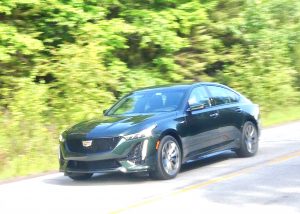
The only green prettier than Duluth foliage might be the Evergreen Metallic of the 2020 Cadillac CT5-V Series.
By John Gilbert
Another quiz on new car identification? Park a 2020 Cadillac CT5 sedan between a CT4 and a CT6, with all of them pointing right toward you. Try to tell them apart, from the vertical rows of running lights on both front fenders to outline their “signature” grilles.
If the CT5 was the V-Series, painted Evergreen Metallic, as was my test car, that would be my pick, because I think it’s the most beautiful green I’ve ever seen on a car.
The near-identical looks are even more similar within the CT5 line itself, with the V-Series aimed at high-performance, and the regular CT5 targeting luxury. It all makes me wonder what I’d have done as a little kid, when my passion for cars far outstripped their aesthetic appeal and technical capabilities. In the 1950s, I would walk out to the top of the big hill we lived on, and watch for any approaching cars on our then-gravel road, and fix my gaze down a couple miles toward Lake Superior’s North Shore Drive. My plan was to see how close an approaching car would have to get before I could identify it. I could discern a 1952 Ford from a 1951 DeSoto, or a 1953 Chevrolet, from a 1950 Cadillac. There weren’t many different models back then, and the proliferation of models would make that a lot more challenging in later years.
The Plymouths and DeSotos of my childhood, as well as Oldsmobile, Pontiac, and American Motors, have all disappeared, among others, and now we’re evolving to fewer and fewer sedans and more and more trucks. But back then, I could discern a 1952 Ford as opposed to a 1951 DeSoto, or a 1953 Chevrolet, or a 1950 Cadillac. There weren’t many different models back in the 1950s, and the proliferation of models would make that a lot more challenging in later years.
Cadillac, however, is still the pinnacle of General Motors, although its models have been reduced to those three remaining sedans. Forget Fleetwood, or de Ville — we’re into CT4, CT5, and CT6. Before they are further reduced, let’s check out the CT5.
I had occasion to get a pair of CT5 sedans back-to-back recently, with the first being a CT5 V-Series. Under the heading of “you can’t tell the players without a program,” my biggest question is why, with only three sedans left, would Cadillac want to make all three look practically identical? Furthermore, it’s interesting that there also is a distinction between the luxury CT5 and the high-performance CT5 V-Series high performer.
That V-Series designation means it was the hot-rod version of the CT5, with a 3.0-liter V6, twin turbocharged to deliver 360 horsepower and 405 foot-pounds of torque, through all-wheel drive. The horsepower peak is at 5,400 RPMs and the torque peaks at 2,350.
The CT5 V-Series was a treat to drive, with dark grey leather bucket seats, and refined comfort throughout. The most pleasant surprise is the V-Series suspension, which is listed as a “luxury compact” in size. It is plenty roomy, which no makes me wonder whether Cadillac is going to stretch the CT5 into the full-size region, or if the compact segment has grown to such dimensions.
The CT5 V-Series accelerates well, with a proper sporty car sound, and you can shift the 10-speed automatic with steering wheel paddles if you want to exploit its sportiest tendencies. The look, with quad tailpipes, and low-profile “summer only” run-flat tires on 19-inch ‘premium painted alloy wheels with pearl nickel finish,” if you’re interested in wheels to that extent. Run-flats work well if you suffer a blowout from a road irregularity and would rather drive on home than have to change a tire. But they are enormously expensive to replace, and they don’t just keep running indefinitely.
Rear seat room is good, even if you have to duck your head a bit to avoid the sloping roof, and the trunk is spacious. Overall, the CT5 V-Series lives up to its billing and is a very satisfying drive. Fuel economy is estimated at 17 city and 25 highway, with a 20 miles per gallon combined figure by the EPA, and if you switch it away from sport you still may have trouble getting more than 20 with all that tempting power.
With magnetic shocks that GM has tried on various Corvettes in the last decade, the V-Series handles very well, and with the blacked-out trim all around, it sets itself apart as a high-performer. Never mind all the creature comforts, with the rear camera, park assist, cross-traffic alert, forward collision alert, lane change alert with blind-spot, nd front pedestrian braking, and the driver awareness package that includes one keep assist with departure warning, head-up display, and “intellibeam” headlights.
Then we get back to the appeal of such a stunning dark green. My wife, Joan, thought it was black for the first night and day she observed me zipping in and out of the driveway. Then she, too, admired the green. We never had occasion to tax the all-wheel-drive system, but it added to the feeling of stability wherever we drove. Base price of the CT5 V-Series is $47,695, and the various upgrades lift it to $58,305.
It was with some disappointment that I awaited the press-fleet guys to arrive from Chicago a week later to pick up the CT5 V-Series, even though they were swapping me into a “Premium Luxury” version of the CT5. But as they rolled into my driveway, I was impressed by the “Garnet Metallic” paint — a dark, deep red that may not have approached the appeal of the unique green, but it was close.
They looked good side by side, and you’d have to look very closely to realize the V-Series had an inch larger wheel diameter and lower-profile tires, Technically, the 18-inch wheels on the Premium Luxury model were “Premium painted alloy with Manoogian Silver finish,” mounted with all-season self-sealing tires. The inch-thicker tires helped give the Premium Luxury CT5 a slightly softer and less performance-oriented ride, and as if to give me a test of perceptions in my driving, it didn’t feel anywhere near as racy as the V-Series.’
It was, however, an eye-opener to examine the differences in powertrains between the two cars. Cadillac fits a base 2.0-liter turbocharged 4 into the base CT5, but the Premium Luxury had, of all things, a “3.0-liter turbocharged V6, with 360 horsepower and 405 foot-pounds of torque” — exactly the same as the V-Series! It also had the same 10-speed automatic transmission, and the same paddle shifters, although lacking the magnesium paddles of the V-Series. It also lacked the quad exhaust tips, the rear spoiler, and the throaty sound of its racier sibling.
But my perception had to be upgraded after learning that it had the same drivetrain, and we started driving it a little more forcefully. As anticipated, the V-Series was plenty luxurious, and the Premium Luxury model was plenty sporty, after we drove it a few days.
The interior of the Premium Luxury Caddy also was leather, in a soft beige, and the Bose audio system was declared a premium unit, with 15 speakers. Otherwise, the equipment was remarkably the same, including the all-wheel-drive system, with EPA fuel-economy estimates of 18 city, 25 highway and 21 combined — one mpg higher in the city than the V-Series.
The sticker on the luxury-loaded Premium Luxury model showed $40,695, with added options lifting it to $52,155.
What price performance? In the case of the Cadillac CT5, it’s about $5,000 more for the V-Series. Worth it, if you like the sound and the style of magnesium paddles, the blacked-out grille and trim features of the V-Series. The Evergreen Metallic that cost an extra $625 on the V-Series, is offset by the Garnet Metallic’s $625. Both paint schemes are probably available on both cars. Take your pick.
I’m going green.


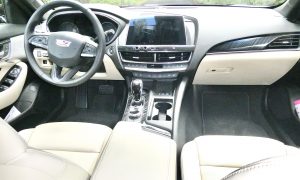
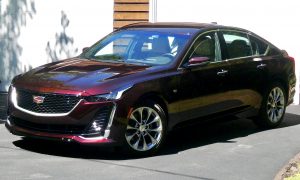
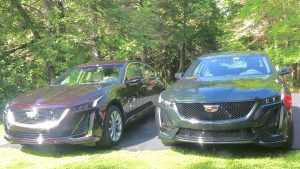
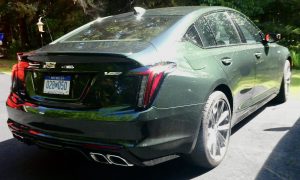
 John Gilbert is a lifetime Minnesotan and career journalist, specializing in cars and sports during and since spending 30 years at the Minneapolis Tribune, now the Star Tribune. More recently, he has continued translating the high-tech world of autos and sharing his passionate insights as a freelance writer/photographer/broadcaster. A member of the prestigious North American Car and Truck of the Year jury since 1993. John can be heard Monday-Friday from 9-11am on 610 KDAL(www.kdal610.com) on the "John Gilbert Show," and writes a column in the Duluth Reader.
John Gilbert is a lifetime Minnesotan and career journalist, specializing in cars and sports during and since spending 30 years at the Minneapolis Tribune, now the Star Tribune. More recently, he has continued translating the high-tech world of autos and sharing his passionate insights as a freelance writer/photographer/broadcaster. A member of the prestigious North American Car and Truck of the Year jury since 1993. John can be heard Monday-Friday from 9-11am on 610 KDAL(www.kdal610.com) on the "John Gilbert Show," and writes a column in the Duluth Reader.